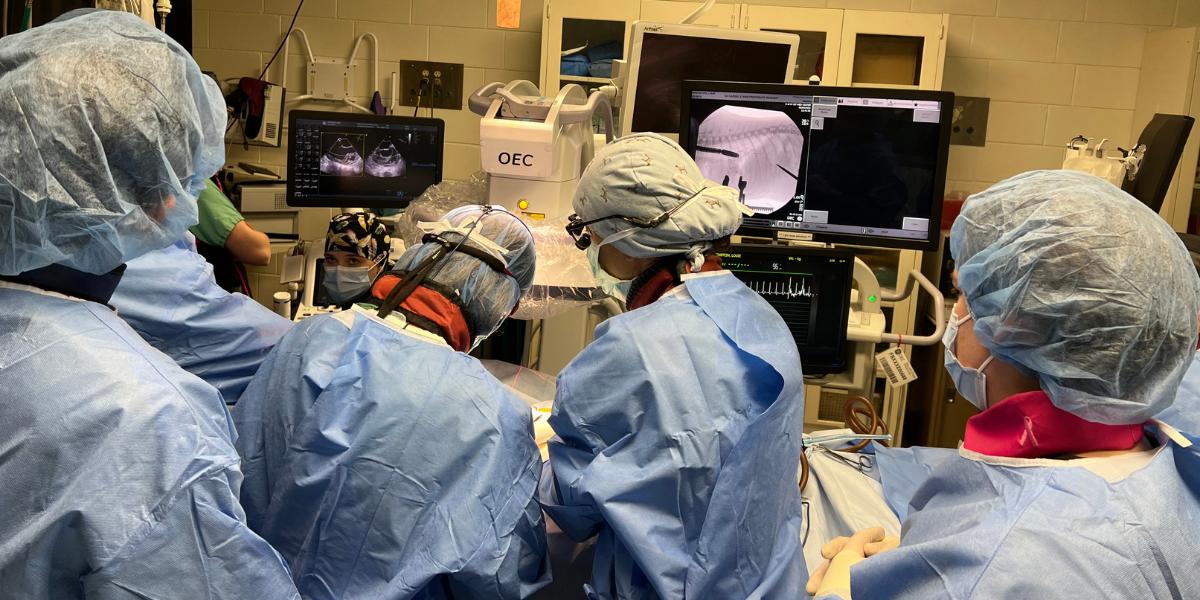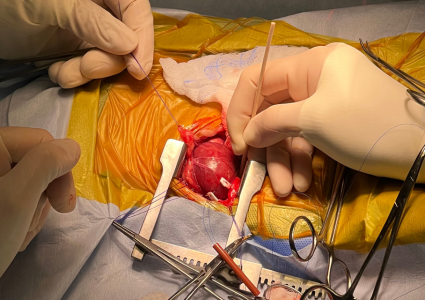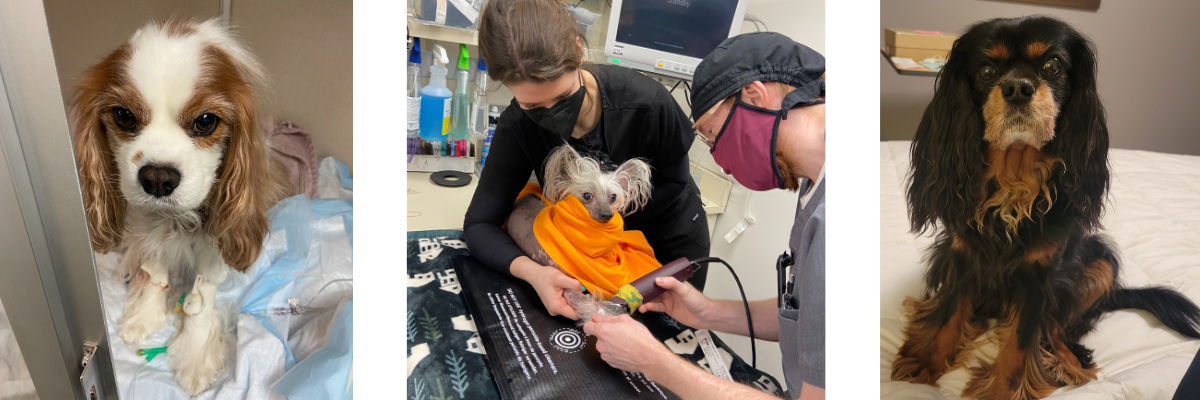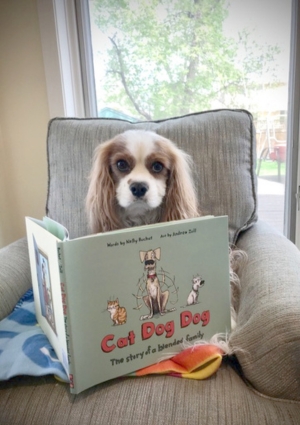Clamping down on valve disease
Cutting-edge cardiac procedure now saving canine lives at Veterinary Medical Center

Cutting-edge cardiac procedure now saving canine lives at Veterinary Medical Center
Veterinary Medical Center clinicians and technicians work on Louie, an 8-year-old Cavelier King Charles Spaniel undergoing a procedure to place a V-Clamp on his heart's mitral valve in the Lewis Small Animal Hospital.
A trio of dogs sharing a heart condition has been given a chance at a longer life thanks to a new surgical procedure performed at the University of Minnesota Veterinary Medical Center (VMC).
The procedure seeks to treat mitral valve disease, a form of heart disease that is extremely common in dogs. In fact, about 90 percent of small breed dogs will develop the disease by age 13, according to Dr. Chris Stauthammer, head of the VMC’s Lewis Small Animal Hospital Cardiology Service. In humans, the condition is treated through open-heart surgery, valve repair, or even heart transplants. In dogs, it’s a different story as these treatment options often are not viable due to their high mortality rate and high costs.

“We've been able to modify this disease process and kind of slow things down with medications but have never been able to address the primary problem or, certainly, fix it,” Stauthammer says.
Now, the Lewis Small Animal Hospital’s cardiology team can treat the disease by implanting a medical device called a ValveClamp, or V-Clamp, through a procedure known as a transcatheter edge-to-edge repair.
The mitral valve of the heart is small in size but can cause large problems if it fails to do its job properly. Located between two chambers of the heart—the left ventricle and atrium—the valve is composed of two tissue flaps that come together to prevent blood from flowing backward as the heart pumps.
When the mitral valve’s flaps don’t seal completely when closed, blood leaks back into the atrium. This leakage, known as mitral regurgitation, forces the heart to work harder to pump blood. If left untreated, this disease can lead to congestive heart failure, other significant heart dysfunction, and patient death.
The V-Clamp is implanted in the heart using minimally invasive surgical methods. An incision is made into the abdomen to gain access to a patient’s heart. Another incision is made into the heart wall, and the clamp is inserted using a catheter. The V-Clamp staples the two valve flaps together, allowing the valve to open and close as normal but preventing or decreasing the amount of regurgitation.
“The V-Clamp conveys a great deal of stability to the mitral valve,” Stauthammer says. “It lessens the amount of leakage and also seems to prevent it from progressing further.”

The cardiology team performed its first set of V-Clamp surgeries in February and March. The surgeries followed training with cardiology peers at Colorado State University and the device’s manufacturer, Shanghai Hanyu Medical Technology Company. The trio of patients—Louie and Royal, both Cavalier King Charles spaniels, and Mia, a Chinese crested dog—are recovering well from their procedures.
Both Louie and Royal’s owners were aware of the breed’s predisposition to heart disease. Louie’s owner Debbie Orenstein, who had lost a previous spaniel to mitral valve disease, was heartbroken to learn he too had the disease in 2021 but was hopeful when his care team determined he would be a good fit for the V-Clamp procedure.

Royal received his diagnosis several years ago and has been a regular visitor of the Cardiology Service after his condition worsened, says his owner Margot Nesbitt. His care team also thought he could benefit from the treatment.
“During one of Royal’s visits, the team mentioned a new procedure they were exploring and tested Royal to see if he would be a good candidate,” Nesbitt says. “The team was fantastic at providing easy-to-understand data, explaining the procedure, outcomes, and risks.”
After undergoing successful procedures, Louie and Royal are slowly returning to their normal lives. Their recoveries require lots of rest and limited activity.

Louie is a registered therapy dog, and Orenstein looks forward to his return to his job—sitting calmly as children read to him in schools and libraries. As a kind and unflappable dog, it’s a role he’s well-suited for, and Orenstein is happy he’ll be able to spend more time doing it thanks to the V-Clamp procedure.
“My husband and I could not be more grateful to Dr. Stauthammer and to everyone who has given Louie the opportunity to extend his life and to enable him to keep doing what he does and to be part of our family,” she says.
Royal also is getting back to his favorite activities, including snuggling with humans and his sister, enjoying time by the river and lakes, and donning his winter exploring gear. Nesbitt is grateful for the improvement to his health and quality of life that the procedure has brought.
“Their technical expertise and—equally important—deep, genuine care for Royal will always be cherished,” Nesbitt says. “The team cares for his total health and well-being like he is a family member, which has been the greatest gift.”
Support cutting-edge veterinary medicine
Philanthropy is crucial to expanding access to new procedures like the transcatheter edge-to-edge repair procedure. Make a gift today to support bringing life-saving care to pets.